Republic Square, Yerevan
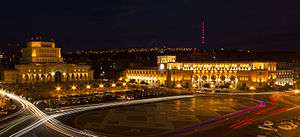 The History Museum and the National Gallery (left) and the Government House (right) in Republic Square as seen at night, 2013 | |
| Former name(s) | Lenin Square (1940–1990)[1] |
|---|---|
| Maintained by | Yerevan Municipality |
| Area | 3 hectares (30,000 m2)[1] |
| Location | Kentron, Yerevan, Armenia |
| Nearest metro station | Republic Square |
| Construction | |
| Construction start | 1926[2][3][4] |
| Completion | 1977[2] |
| Other | |
| Designer | Alexander Tamanian |
Republic Square (Armenian: Հանրապետության հրապարակ, Hanrapetut′yan hraparak, known locally as Hraparak, "the square")[5][6] is the central town square in Yerevan, the capital of Armenia. It consists of two sections: an oval roundabout and a trapezoid-shaped section which contains a pool with musical fountains. The square is surrounded by five major buildings built in pink and yellow tuff in the neoclassical style with extensive use of Armenian motifs.[7][8] This architectural ensemble includes the Government House, the History Museum and the National Gallery, Armenia Marriott Hotel and the ministries of Foreign Affairs and Transport and Communications. The square was originally designed by Alexander Tamanian in 1924.[9] The construction of most of the buildings was completed by the 1950s; the last building—the National Gallery—was completed in 1977.[2]
During the Soviet period it was called the Lenin Square and a statue of Vladimir Lenin stood at the square and military parades were held twice (originally thrice) a year. After Armenia's independence Lenin's statue was removed and the square was renamed.[10] It has been described as Yerevan's "architectural highlight"[11] and the city's "most outstanding architectural ensemble".[12] Travel writer Deirdre Holding suggested that it is "certainly one of the finest central squares created anywhere in the world during the 20th century."[13] As Armenia's and the city's "most important civic space",[14] Republic Square was the main site of demonstrations during the 2018 Velvet Revolution.
Architecture
The square consists of two sections. The oval roundabout that has a stone pattern in the center, meant to look like a traditional Armenian rug from above. The trapezoid-shaped section which contains the musical fountain in front of the History Museum and the National Gallery.[3] The buildings around the square are made of pink and yellow tuff stones, fortified on a basalt-made ground anchor.
History
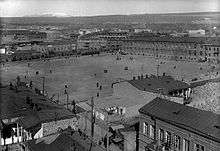
A town square of different proportions existed at its location for centuries.[15] In 2003 the square was renovated and extensive excavations took place. An older layer—from the 18th-19th centuries—was uncovered.[16] The pre-Soviet square was designed by Boris Mehrabyan (Megrabov) in his 1906-11 general plan of Yerevan.[17]
The current square was designed by Alexander Tamanian within his 1924 general plan of Yerevan.[18] The construction of the square started in 1926, when the Government House began.[4][3] It was developed until the 1950s when the rest of the five buildings were constructed and finally completed in 1977, when the National Gallery was built. The square was named Lenin Square (Armenian: Լենինի հրապարակ, Lenini hraparak; Russian: площадь Ленина ploshchad’ Lenina) for Soviet leader Vladimir Lenin, whose statue was erected in the square in 1940 and dismantlement in 1991, prior to the independence of Armenia.
Landmarks
Buildings
| Building | History and use |
|---|---|
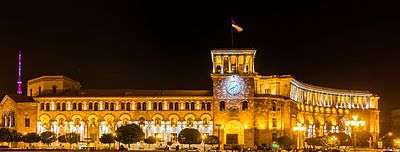 |
The building is home to the Government of Armenia (the council of government ministers and not the entire executive branch). It originally housed the People's Commissariat (the executive of Soviet Armenia).[2][9]
The north-western portion, built in 1926-29, was designed by Alexander Tamanian.[3] The construction of the rest of the building was taken up by Gevorg Tamanian, Alexander's son, in 1938[19] and finished in 1941.[2][9] |
 |
History Museum of Armenia, National Gallery of Armenia
The buildings began in the 1950s with the National Gallery building being completed in 1977.[2][20] It was designed by Mark Grigorian and Eduard Sarapian.[2] A small portion of the ensemble, the Arno Babajanyan Concert Hall, dates back to 1916.[2] |
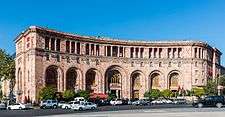 |
It was completed in 1958 according to the design of Mark Grigorian and Eduard Sarapian.[2][21] The hotel was called Armenia during the Soviet period. A luxury hotel, it is considered the flagship hotel of Armenia.[22][23] It has 380 rooms.[24] |
 |
The building was designed by Samvel Safaryan, Rafael Israelyan, Varazdat Arevshatyan[2][25] and completed in 1955.[2][26] The friezes above first-floor windows are incomplete.[27] The building was home to the Ministry of Foreign Affairs between 1996 and 2016.[26] |
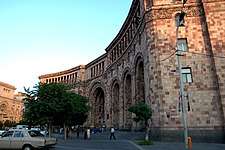 |
Built in 1933[19]-1956, it was designed by Mark Grigorian and Eduard Sarapian.[2] The building was home to Ministry of Transport and Communications until 2016.[27] |
Statue of Lenin
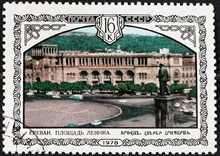
A 7-meter statue of Soviet leader Vladimir Lenin, erected by Sergey Merkurov and standing atop an 11 meter high pedestal, was inaugurated in the square on November 24, 1940.[28][29] The monument faced the site of the planned National Gallery and "soon gained considerable acclaim as a great piece of monumental art."[30] The statue was removed from the pedestal on April 13, 1991 prior to the formal dissolution of the Soviet Union. It was "placed on a truck and, like the body of a deceased person, driven round and round the central square as if in an open coffin" while people cheered.[31] It is now located at the yard of the National Gallery. The pedestal survived until the summer of 1996, when it was demolished.[28]
Replacements
Ter-Ghazaryan writes that "After the monument to Lenin was toppled, the balance of Republic Square was thrown off, and the empty space left where Lenin used to stand has been subject to various design proposals, but none has succeeded."[30]
On December 31, 2000 a 24-meter cross lit by light-bulbs was erected in the space left empty by Lenin’s pedestal. This installation was completed on the eve of 2001, which was when the Armenian state and the Armenian Apostolic Church celebrated the 1700th anniversary of being a Christian nation. The cross was lit by 1700 symbolic lamps, and continued to be at the center of celebrations that took place throughout the year of commemoration. However, at the end of 2001, the period of celebration ended and the cross was quietly dismantled. Since it was a temporary fixture, there was little discussion preceding its erection, as well as after its dismantling.[14]
In February 2004 a billboard-sized television screen playing advertisements for various organizations and products appeared in the empty space.[32] It was removed in 2006.[14]
- Proposals
Several competitions have been held in Armenia to select a replacement for the statue of Lenin. One of the most common proposals is to move the monument of Sasuntsi Davit (David of Sasun) to Republic Square. According to Ter-Ghazaryan the largely apolitical nature of this Armenian national hero of an epic novel would be a safe choice; however, she wrote in 2013 that the relocation of the monument from its current spot in front of Yerevan Railway Station "seems unlikely."[33]
Fountains
After years of non-operation, the musical fountains were renovated by the French company Aquatique Show International[34] and costed around €1.4 million.[35] They were opened in September 2007.[36]
Christmas tree
A Christmas tree has been installed at the square every December since at least 1950.[37]
Drinking fountain
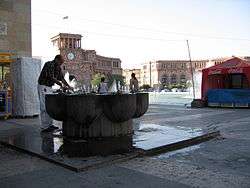
The drinking fountain (also known as pulpulak), located next to the museums' buildings, consists of seven fountains and is thus called Yot aghbyur ("Seven springs"). It was originally installed in 1965 and renovated in 2010.[34]
Events and incidents
Parades
During the Soviet times military parades were held the square on May 1 (the International Workers' Day), May 9 (Victory Day, until 1969)[28] and November 7 (October Revolution).[38][28] The leadership of Soviet Armenia stood at the podium, below Lenin's statue.[38] The last of these parades were held in 1988.[28]
Military parades celebrating the independence of Armenia have been held on September 21 of 1996 (5th anniversary),[39] 1999 (8th anniversary),[40] 2006 (15th anniversary),[41][42] 2011 (20th anniversary),[43] 2016 (25th anniversary).[44]
Concerts
On September 30, 2006 French-Armenian singer Charles Aznavour performed a concert at Republic Square.[45]
On April 23, 2015 the Armenian-American rock band System of a Down gave their first-ever concert in Armenia in Republic Square. The free concert was dedicated to the 100th anniversary of the Armenian Genocide and was attended by thousands.[46][47][48]
On June 8, 2017 Russian hip-hop artist Timati gave a free concert in the square, which was attended by more than 40,000 people.[49]
Political demonstrations
- Soviet period
On April 24, 1965 large demonstrations took place in the square and elsewhere in Yerevan to commemorate the 50th anniversary of the Armenian Genocide.[50][51][52]
In January 1974 Razmik Zohrapyan, a member of the underground National United Party burned the portrait of Lenin at the square in protest of Soviet totalitarian rule.[53]
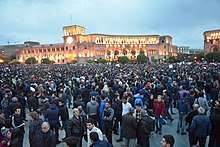
- Independent Armenia
Following the 2008 presidential election president-elect Serzh Sargsyan held a rally of 60,000–70,000 "would-be supporters" who were brought from different parts of Yerevan and Armenia in buses. Many of them headed towards Freedom Square where a competing rally was being held by Levon Ter-Petrosyan.[54] In March, following the violent crackdown of opposition demonstrations, the square was occupied for some time by the Armed Forces of Armenia.[55]
On May 4, 2012 during a Republican Party rally and concert at Republic Square in scope of the parliamentary election campaign, dozens of balloons filled with hydrogen exploded, resulting in the injury of at least 144 people.[56][57]
From April 17 to 23, 2018 large demonstrations took place at Republic Square led by Nikol Pashinyan against the government of newly-elected Prime Minister Serzh Sargsyan. On April 22, when opposition leader Pashinyan was arrested, police forces were deployed in the square. Dozens of protesters were detained from the square.[58][59] By the evening, some 115,000 protesters filled the entire square and the nearby streets.[60] The next day, on April 23, after Sargsyan resigned, it became the center of mass celebrations.[61][62] On April 24, the Armenian Genocide Remembrance Day, dozens of protests came together to clean the square and its adjacent street.[63]
Other events
In 1968 the celebration of Yerevan's 2750th anniversary were staged on the square with extravagant celebrations.[38]
On June 25, 2016 Pope Francis and Karekin II held an ecumenical prayer at Republic Square.[64][65] It was attended by some 50,000 people.[66]
References
- 1 2 Հանրապետության հրապարակ [Republic Square] (in Armenian). Հայկական Համառոտ Հանրագիտարան (Concise Armenian Encyclopedia). 1999. p. 296.
- 1 2 3 4 5 6 7 8 9 10 11 12 Government of the Republic of Armenia (2 November 2004). "Հայաստանի Հանրապետության Երևան քաղաքի պատմության և մշակույթի անշարժ հուշարձանների պետակական ցուցակ [List of historical and cultural monuments of Yerevan]". arlis.am (in Armenian). Armenian Legal Information System. Archived from the original on 5 August 2016.
- 1 2 3 4 Tigranian 1985, p. 25.
- 1 2 Avetisyan 1979, p. 80.
- ↑ Pechakjian, Pauline (28 April 2016). "The 10 Best Hotels & Inns in Yerevan, Armenia". theculturetrip.com.
...Republic Square, referred to by locals as the Hraparak...
- ↑ "De-Sovietized Streets". Armenian International Magazine: 17. September 2001.
The street just off Hraparak...
- ↑ Louis, Victor E.; Louis, Jennifer M. (1987). Louis motorist's guide to the Soviet Union. Pergamon Press. p. 517. ISBN 9780080318172.
The centre of Erevan is Lenin Square; it was built as an architectural whole using the Armenian national style of architecture.
- ↑ Gregorian, Vartan (2008). The Road to Home: My Life and Times. Simon and Schuster. p. 178. ISBN 9781439129111.
Buildings around the square were designed to reflect some features of ancient Armenian architecture.
- 1 2 3 "Government Building History". Government of the Republic of Armenia. Archived from the original on 4 August 2016.
- ↑ Schmemann, Serge (8 July 1992). "In the Caucasus, Ancient Blood Feuds Threaten to Engulf 2 New Republics". The New York Times.
On the former Lenin Square, now Republic Square, the statue of Lenin is gone and his pedestal is being prepared for demolition.
- ↑ Travel to the USSR (92–103): iii. 1983.
The city's architectural highlight is Lenin Square, with its statue of Lenin, Government House, the Armenia Hotel, the picture gallery and other buildings. The main streets branch out from Lenin Square.
Missing or empty|title=(help) - ↑ Gross, Eugenie Harris; Gross, Jeffrey (1977). The Soviet Union: a guide for travellers. J. Murray. p. 255.
Lenin Square, at the center of the city, contains the most outstanding architectural ensemble in Yerevan. The buildings surrounding the square express a single architectural concept.
- ↑ Holding, Deirdre (2014). Armenia: with Nagorno Karabagh. Bradt Travel Guides. p. 128. ISBN 9781841625553.
- 1 2 3 Ter-Ghazaryan 2013, p. 584.
- ↑ Brookes, Richard (1820). The General Gazetteer; or Compendious Geographical Dictionary (17th ed.). London. p. ERN-ERZ.
Erivan ... The Meidan is and open square, 400 paces over, in which are very fine trees.
- ↑ "Yerevan Walking Tour: Republic Square Excavations". armenianheritage.org. Armenian Monuments Awareness Project.
- ↑ "Հանրապետության հրապարակ". yerevan.am (in Armenian).
- ↑ Ter-Ghazaryan 2013, p. 579.
- 1 2 Tigranian 1985, p. 27.
- ↑ "1947-1991 Հայաստանի պետական պատկերասրահ [1947-1991 The State Gallery of Armenia]". gallery.am (in Armenian). National Gallery of Armenia.
- ↑ Gevorgian, A. O. (1979). "Yerevan". The Great Soviet Encyclopedia.
The main architectural ensemble of the city is Lenin Square, at which several streets converge. On the square are a monument to V. I. Lenin (cast bronze, 1940, sculptor S. D. Merkurov), the Government House of the Armenian SSR (1926-41, A. I. and G. A. Tamanian), the second Government House (1955, S. A. Safarian, V. A. Arevshatian, and R. S. Israelian), the Armenian Historical Museum (1975), the Hotel Armenia (1958), and the building of the Communications Ministry and the Trade Union Council (1956-58); the last three were designed by M. V. Grigorian and E. A. Sarapian.
view article online - ↑ "Armenia Marriott Hotel Yerevan". marriott.com.
- ↑ Karanian, Matthew; Kurkjian, Robert (2002). Edge of Time: Traveling in Armenia and Karabagh. Stone Garden Productions. p. 78. ISBN 9780967212029.
The country's flagship hotel is still the massive Hotel Armenia, which faces Republic Square in the heart of the city. In 2003 the hotel will be renamed the Armenia Marriott Hotel Yerevan to reflect its new ownership.
- ↑ "Marriott". Asian Hotel & Catering Times. 26: 7. 2001.
...the 380-room Armenia Marriott Hotel Yerevan.
- ↑ "Սամվել Սաֆարյան վաստակավոր ճարտարապետ [Samvel Safaryan]". archmuseum.am (in Armenian). National Museum-Institute of Architecture of Armenia.
...Կառավարական 2-րդ շենքը Երևանի Հանրապետության հրապարակում (համահեղինակներ՝ Ռ.Իսրաելյան, Վ.Արևշատյան)...
- 1 2 "History". mfa.am. Ministry of Foreign Affairs of the Republic of Armenia. Archived from the original on 4 August 2016.
- 1 2 "Շրջայց Երևանով. Հանրապետության հրապարակ [Yerevan Walking Tour: Republic Square]". armenianheritage.org (in Armenian). Armenian Monuments Awareness Project.
- 1 2 3 4 5 "Լենինի արձան` (ան)կենդանի պատմություն". mediamax.am (in Armenian). 27 November 2012. Archived from the original on 4 August 2016.
- ↑ "Խոսող կոթողներ. Լենինի արձան". 1tv.am (in Armenian). Public Television of Armenia. 10 July 2015. Archived from the original on 8 August 2016.
- 1 2 Ter-Ghazaryan 2013, p. 583.
- ↑ Verdery, Katherine (1996). What Was Socialism, and What Comes Next?. Princeton University Press. p. 232. ISBN 9781400821990.
- ↑ Tuayeva, Salima (6 February 2004). "From Vladimir to Video: Action movies replace a stoic dictator in Republic Square". ArmeniaNow.
- ↑ Ter-Ghazaryan 2013, p. 585.
- 1 2 "Հրապարակի շատրվաններն ու ցայտաղբյուրը` կենդանի պատմություն". mediamax.am (in Armenian). Mediamax. 3 April 2013.
- ↑ "Հրապարակում ջրային հրավառություն է լինելու". Aravot (in Armenian). 25 June 2007.
- ↑ "Երևանի Հանրապետության հրապարակի շատրվանները կգործարկվեն մինչև նոյեմբերի 1֊ը" (in Armenian). Armenpress. 27 September 2007.
- ↑ "Ամանորը եւ տոնածառը Երեւանում` կենդանի պատմություն". mediamax.am (in Armenian). Mediamax. 26 December 2012.
- 1 2 3 Ter-Ghazaryan 2013, p. 582.
- ↑ "Զորահանդես. 7 տարվա ընթացքում ոչ մի նոր տեխնիկա" (in Armenian). A1plus. 21 September 2006. Archived from the original on 9 August 2016.
...1996 եւ 1999 թվականների զորահանդեսների...
- ↑ "Armenia Marks Independence Anniversary With Military Parade". Asbarez. 21 September 1999.
- ↑ "Հանրապետության հրապարակում անցկացվեց զորահանդես` նվիրված ՀՀ անկախության 15րդ տարեդարձին" (in Armenian). Armenpress. 21 September 2006. Archived from the original on 9 August 2016.
- ↑ "Military parade is over in Yerevan: Armenian tricolor in the sky and 15 artillery salvos (photo report)". REGNUM News Agency. 21 September 2006. Archived from the original on 25 May 2009.
- ↑ Danielyan, Emil (21 September 2011). "Armenia Parades Military Might On Independence Day". azatutyun.am. Radio Free Europe/Radio Liberty Armenian Service.
- ↑ "Military Parade Highlights Independence Day Celebrations in Armenia". Asbarez. 21 September 2016.
- ↑ "Charles Aznavour's concert in Armenia". repatarmenia.org. Repat Armenia Foundation.
- ↑ Westcott, Lucy (23 April 2015). "System of a Down's Pilgrimage to Commemorate the Armenian Genocide". Newsweek.
- ↑ "Watch System of a Down's First Ever Armenian Show". Rolling Stone. 23 April 2015.
- ↑ "Tankian's Message: SOAD vocalist speaks to crowd on Genocide during concert in Yerevan". ArmeniaNow. 24 April 2015.
- ↑ "Տիմատիի բացօթյա համերգին Երևանում ավելի քան 40.000 հանդիսատես էր հավաքվել" (in Armenian). PanARMENIAN.Net. 9 June 2017.
- ↑ Malkasian, Mark (1996). Gha-ra-bagh!: The Emergence of the National Democratic Movement in Armenia. Wayne State University Press. p. 76. ISBN 9780814326046.
They were also among the university students who skipped classes on 24 April 1965, marching instead toward Yerevan's Lenin Square...
- ↑ Petrone, Karen (2011). The Great War in Russian Memory. Indiana University Press. p. 288. ISBN 9780253001443.
- ↑ Lieberman, Benjamin (2013). The Holocaust and Genocides in Europe. A&C Black. p. 213. ISBN 9781441194787.
On the fiftieth anniversary of the Armenian Genocide thousands gathered in Lenin Square in the Yerevan...
- ↑ Payaslian, Simon (2011). The Political Economy of Human Rights in Armenia: Authoritarianism and Democracy in a Former Soviet Republic. I.B. Tauris. p. 87. ISBN 9780857731692.
In January 1974, Razmik Zohrapyan, a member of the NUP, burned Lenin‖s picture in Lenin Square (now Republic Square) in protest of Soviet totalitarian rule.
- ↑ Pennington, Joseph (28 February 2008). "LTP AND SARGSIAN HOLD DUELING RALLIES; LTP WINS HANDS DOWN". WikiLeaks. Embassy of the United States, Yerevan.
- ↑ Tavernise, Sabrina (3 March 2008). "Emergency Order Empties Armenian Capital's Streets". The New York Times.
By Sunday night, military units moved in, taking up position at places like the government buildings at Republic Square.
- ↑ "Vote 2012: Accident at RPA rally causes 144 injuries". ArmeniaNow. 4 May 2012.
- ↑ Stepanian, Ruzanna; Shoghikian, Hovannes (4 May 2012). "Scores Injured As Balloon Blasts Spark Chaos At Armenian Election Rally". azatutyun.am. Radio Free Europe/Radio Liberty Armenian Service.
- ↑ "Armenian Protesters Detained At Yerevan's Central Square". Radio Free Europe/Radio Liberty. 22 April 2018.
- ↑ "Police forces deployed to Republic Square, protesters being detained (VIDEO)". news.am. 22 April 2018.
- ↑ Kucera, Joshua (22 April 2018). "Armenian opposition leader arrested, but protesters rally". eEurasianet.
- ↑ Navasardian, Boris (23 April 2018). "Armenia looks to the future as protesters celebrate resignation of Prime Minister Serzh Sargsyan". The Independent.
- ↑ "Thousands Celebrate As Armenia's Longtime Ruler Sarkisian Steps Down". RFE/RL. 23 April 2018.
- ↑ Ghazaryan, Diana (24 April 2018). "Yerevan's Republic Square: Protest Epicenter Gets Citizen Clean-Up". Hetq Online.
- ↑ "Ecumenical Prayer Vigil for Peace: Address of the Holy Father". vatican.va. Yerevan, Republic Square: Holy See. 25 June 2016.
- ↑ "Pope Francis Holds Ecumenical Service at Yerevan's Republic Square". Armenian Weekly. 26 June 2016.
- ↑ Povoledo, Elisabetta (25 June 2016). "Pope Francis to Armenians: Seek Peace, but Never Forget Genocide". The New York Times.
Bibliography
- Ter-Ghazaryan, Diana K. (2013). ""Civilizing the city center": symbolic spaces and narratives of the nation in Yerevan's post-Soviet landscape". Nationalities Papers. 41 (4): 570–589. doi:10.1080/00905992.2013.802766.
- Avetisyan, Kamsar (1979). "Երևանի ընդհանուր նկարագիրը (General description of Yerevan)". Հայրենագիտական էտյուդներ [Notes on Armenian studies] (in Armenian). Yerevan: Sovetakan grogh. pp. 72–81.
- Tigranian, Edmond (1985). "Երևանի Վ. Ի. Լենինի անվան հրապարակի քաղաքաշինական ասպեկտները [The town-building aspects of V. I. Lenin square in Yerevan]". Lraber Hasarakakan Gitutyunneri (in Armenian) (9): 24–29.
External links
Coordinates: 40°10′40″N 44°30′46″E / 40.17778°N 44.51278°E